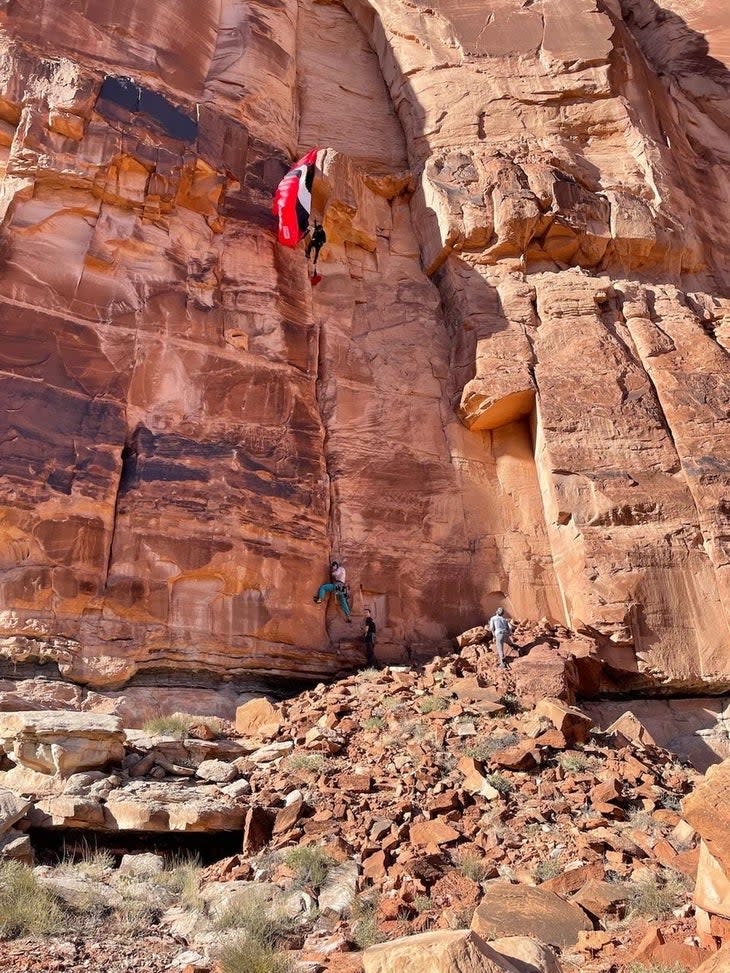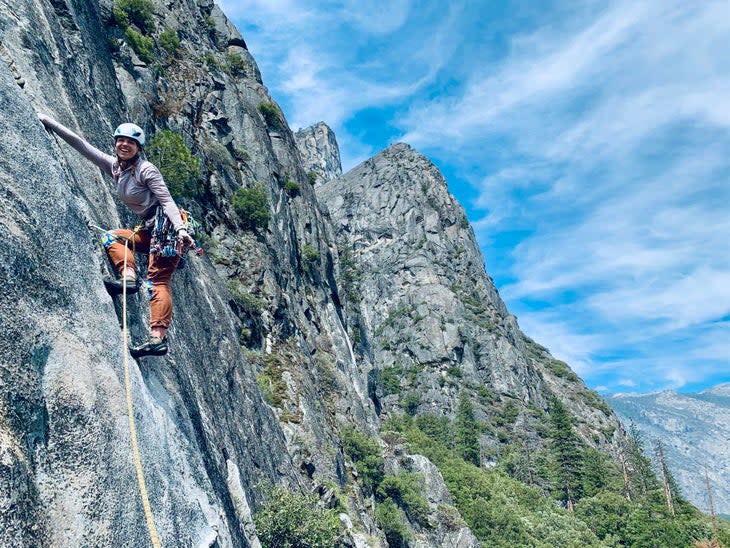Utah Climber Rescues Base Jumper Who Crashed into Cliff
This article originally appeared on Climbing
Utah-based climber River Barry, 30, was standing in a parking lot in Moab's Kane Creek Canyon. She was prepping her gear for a day of mountain biking when a base jumper crashed into the cliff in front of her. At the time, she never imagined that she'd be the only one able to save him.
It was Saturday, November 26, and the annual local base jumping festival Turkey Boogie 2022 was in full swing. One jumper, an Australian man whose name has not yet been disclosed, was just a few hundred feet above the ground when he pulled his parachute. As planned, a scarlet bloom of fabric erupted skyward, slowing his freefall. It probably took him half a second to understand what had gone wrong--and half a second more to realize that instead of sailing away from the cliff face, he was flying straight toward it.
"Basically, when you [base] jump out from the wall, your chute is supposed to open straight out, and you fly away. But it can open in a different direction," explains Justin Beitler, a Las Vegas-based fellow base-jumper who was on the scene the day of the accident. In this case, the victim's chute opened about 160deg "off-heading," or about 160deg in the opposite direction of where it was supposed to. Maybe it was because of his body position, maybe because of some asymmetry in his pack. But by the time he realized what was happening, it didn't matter: the world was reeling around him, and there was nothing he could do.
"His body was spinning, and he didn't have time to reach up and turn his chute," says Beitler. Instead of lifting the victim away from the wall, the parachute sucked him into it, slamming his body against the rock and sending him rag-dolling along the cliff face.
At the time, Barry was with two friends, bent over her bike, pumping up her tires. She didn't see the victim fall, but her friend did. Barry could see the horror register on her friend's face as he turned to her.
"A base jumper just crashed," he said. Barry glanced to the wall where the scarlet chute was now dangling, caught precariously on the end of a sloping ledge, pinned by nothing more than friction and body weight. The victim hung 80 feet off the ground. She felt her breath catch in her throat.
"We were all just watching in terror," she recalls. "That's when this dude came running up to us."
The dude (who turned out to be Beitler) was a friend of the victim and had seen the whole thing happen. He'd bolted down from the wall into the parking lot, leaving two other jumpers to man the unconscious victim. Beitler started shouting as soon as he was within earshot, asking if anyone had trad gear. Barry raised her hand.
"I have a double rack, two harnesses, and a rope in my van," she said. Beitler ran over to her.
"Give me what you've got."
Barry handed him a pack full of cams and packed a separate bag with food, water, and first aid. By the time she started scrambling up the loose approach, Beitler was already nearing the base of the wall.
"My heart was pounding through my chest, but I was in go-mode," Barry says. "It's like you don't think, you just do."
[Interested in learning trad? Check out this course]
After a few minutes, she arrived at the base, started pulling on her harness, and asked Beitler for a mission briefing. For a few moments, he tried to explain his strategy, which involved climbing a crack ten feet to the left of the suspended base jumper and then traversing over. Barry blinked.
"That's not going to work," she said. The traverse was nonexistent. The only way to get to the victim would be to climb the line just beneath him--a wide crack that looked to be about 5.10. Barry, who's been rock climbing for years and has extensive trad experience, explained all this. That's when Beitler confessed that he'd only ever led two trad routes before.
Barry took a breath.

"I realized there was no one else there who was going to do this but me," Barry says. She looked up at the wall. The rock was spattered with blood. The victim was limp, unconscious. She wasn't even sure if he was alive--but she did know that the longer she took to get moving, the higher the odds that a wind would kick up and upset his precarious balance.
The route looked loose and sandy, but she knew she'd be able to get up it. Barry's Wilderness First Responder (WFR) training kicked in, and she started delegating, asking one bystander to flake the rope, ensuring the rest of the scene was safe, and putting Beitler on belay. Together, they made a plan.
"We both knew there was a good chance that [the suspended victim] could fall," Beitler says. If Beitler started screaming "Rock," that's how Barry would know that the victim was coming down.
"River just looked at the situation and said she'd lean into the wall and hope for the best if that happened. And then she just headed up there anyway--for some dude and a group of people she didn't even know," Beitler says. "I was really impressed."
Barry finished racking up and took a deep breath.
"I brought everything I had," she says. "The crack was fists to fours, and then it was all chossy and awful, and then it got so wide I didn't have any gear for it." Still, she kept going, fighting through off-width sections and a narrow squeeze chimney toward a thinner crack at the top.
Meanwhile, blood continued to drip down the wall, spattering the sandstone and Beitler alike. For the first half of the climb, Barry wasn't even sure if the victim was alive. It wasn’t until she was about 40 feet off the deck that she saw he was breathing. But it was too soon for any sense of relief.
"Handholds were popping off left and right. It was so sandy, and the gear was scary--it was hard to tell what was real rock and what was a flake," Barry says.
On top of that, the victim soon began to wake up, rocking against his tenuous lines, slow at first but then more violently. When Barry was close to eye level with him, he spotted her and began to moan.
"Please get the weight off my leg," he begged. "Please help me." He started to move, thrashing to alleviate his discomfort. Barry could see the parachute begin to slip. She could hear the desperation and agony in his voice. It was unnerving.
"He's begging me over and over. He's in so much pain," she recalls. "I have to speak out loud to myself to block him out. 'Take your time. Place safe gear. Take your time. Place safe gear.' And the whole time I'm climbing, I'm saying this to myself and I'm screaming over to him, 'You're a fucking badass. You got this. We're going to get you out of here.'"
Barry reached the victim, built a three-piece anchor, and leaned over to him, holding her breath as she grabbed hold of his chest harness. She clipped him into her anchor, and she felt the first wave of relief. But she wasn't done yet.
Barry climbed a few more feet, built a higher anchor, clipped into him again, and slipped the emergency knife free from the victim's harness. One by one, with her heart in her throat, she began cutting the lines.
When she snipped the last one, she could feel his weight transfer seamlessly from the chute to her harness. Slowly and carefully, she executed the lower.
"I don't think I realized what a big deal this all was until I touched the ground and everyone was saying, 'Thank you,'" Barry says. "Justin just came over and hugged me and held me and said, 'Thank you for saving my friend.' That's when it really hit me."

By then, Grant County Search and Rescue had arrived and were able to package the victim into a litter and get him airlifted to the hospital. (This was one of at least three base jumping accidents in the Moab area that weekend.) Without Barry's quick action, GCSAR would have had to rappel 300 feet from the top of the cliff to reach the victim, an operation that could have taken hours--hours that the victim may not have had to spare. (He's currently in the hospital, and beginning to recover. Beitler and Barry both communicate with him regularly; the three have all since become friends.)
"I just want to say that I'm super impressed by River," Beitler says. "She was super calm the whole time. You would have thought she was leading any other climb on any other day, and she was talking to him and calming him down the whole time. She just killed it."
As for Barry? She's still getting a lot of attention after the rescue--including questions about what she hopes to name the 80-foot route she put up in the process. (She hopes to return to free the line sometime soon.) In the meantime, Barry plans to continue honing her own self-rescue skills. But mostly, she says, her biggest takeaways are more philosophical.
"That day made me realize, one, the fragility of human life and, two, the human capacity to just do," she says. "The human mind and body and soul have such a capacity to show up for someone in need," she says. "I'm grateful to have been able to be there and be able to do my part."
Also Read:
For exclusive access to all of our fitness, gear, adventure, and travel stories, plus discounts on trips, events, and gear, sign up for Outside+ today.


